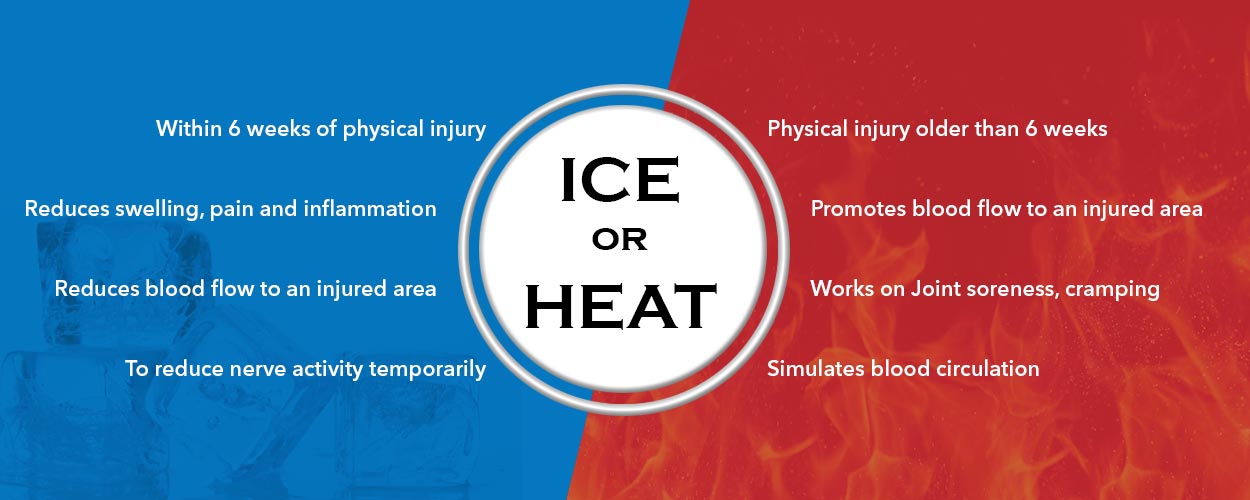- Bariatric Surgery
- Cardiology
- Transplants
- Neurology
- Oncology
- Bladder Cancer Treatment
- Bone Cancer Treatment
- Breast Cancer Treatment
- Colon Cancer Treatment
- Esophagus Cancer Treatment
- Kidney Cancer Treatment
- Leukemia Treatment
- Liver Cancer Treatment
- Lymphoma Treatment
- Lung Cancer Treatment
- Myeloma Treatment
- Prostate Cancer Treatment
- Pancreatic Cancer Treatment
- Ovarian Cancer Treatment
- Testicular Cancer Treatment
- Orthopedics
What’s better - Ice Pack or Heat Therapy?
General Health, Orthopedics
We all must have at least once sprained or twisted an ankle, hurt a muscle or dealt with musculoskeletal pain. And even more times, we must have wondered which therapy to opt – heat/thermal or cold/cryotherapy. These temperature therapies are a great way to self-treat at home and is decidedly a cheap way to do so. Both, heating pad and cold packs can be used for musculoskeletal or orthopaedic disorders, but the tricky part is when to use which! None is better than the other. Therapy with heat and ice have their own particular uses depending on the situation and stage of treatment. It is important to remember – not using temperature based therapies with caution and safety can do even more damage than the initial problem.

Ice Treatment
Basically used for acute injuries to reduce swelling, pain, and inflammation. Ice pack can be applied in a situation where the physical injury has taken place less than 6 weeks and is most effective within 48 hours, to alleviate swelling and pain in the area.
What it does?
The cold treatment is not so cold and mean! The ice therapy helps by reducing blood flow to a particular area that is injured, targeting inflammation and swelling in that area which is the cause of pain. It also aids in reducing nerve activity, although temporarily, which also relieves pain.
To be used for:
For the regular treatment of chronic inflammatory Arthritis, migraine headaches, and trigeminal neuralgia, muscle strains, and strains.
Also during acute pain, gout flare-ups and overuse injuries in athletes including tendinitis (acute irritation of tendons), bursitis. Ice therapy can numb down the pain and soreness acting as a painkiller in such situations.
Not to be used for:
In case of stiff muscles or joints, open wound and numbness in the affected area, cold therapy should be avoided. It should also not be used when the injured person has hypersensitivity to cold, has vascular disease which affects blood flow or problems like diabetes.
How to be used?
- Cold compress/ gels;
- Ice packs or frozen peas/corns;
- Cold towel;
- Ice massage
All these treatments are to be performed under caution in regard to time and application. Ice is not be applied directly on the skin and a cloth barrier should be used between the ice pack and the skin. The pack or compress could be applied in the injured area for 15-20 min. One should also look for redness or pricking sensation while applying these. It should not be used before exercise.
Connect with Experts & Get a Free Personalized Quote
Heat Treatment
Some like it hot! Heat treatment is done for injuries that are older than 6 weeks to soothe the stiff muscles after an injury or before an exercise to promote blood flow. It can work wonders for muscle and joint soreness or cramping and back pain.
What it does?
Applying heat to the affected area can help in promoting blood flow and circulation by dilating the blood vessels. Heat therapy aims at relaxing and healing the damaged muscles and tissue, and improve muscle flexibility. It helps in alleviating the discomfort and help soothe sore and tightened muscles.
There is build-up of substances like lactic acid after vigorous exercise which cause pain in the muscles, applying heat is a highly effective way of alleviating this pain as it stimulates blood circulation which can remove the waste and lactic acid. Thus providing relief, especially to sport active people.
To be used for:
Heat therapy relaxes tissues and promotes blood flow and circulation to the affected joint or muscle. Heat therapy is mainly used before an action is performed in the treatment of overuse injury and provides pain relief in case of muscle tension.
Heating is used in the case of musculoskeletal pains in conditions such as arthritis, old muscle strains to help relax stiff joints. It is also used for treating neck spasms and tendinosis which is the chronic irritation in tendons.
Not to be used for:
Heat should not be applied on open wound areas and should not be used in case of acute injuries as it increases inflammation.
How to be used
- Electrical heating pads
- Hot water bottles
- Hot compress
- Heat wrap
- Warm baths
The important point to remember about heat therapy is that the temperature should not be scalding hot but warm. Heat can be applied for longer duration than ice, i.e. for 20-30 min. but care should be taken to not burn the skin.

Written By Dr. Suneet Singh
Cost Calculator

Top Specialities
- Best Doctors in India
- Best Bariatric Surgeons in India
- Best Bone Marrow Transplant Doctor in India
- Best Cardiologist in India
- Best ENT Doctor in India
- Best Epilepsy Doctors in India
- Best Gastroenterologist in India
- Best Hair Transplant Surgeon in India
- Best Hematologist in India
- Best Hip Replacement Surgeon in India
- Best Infertility Doctor in India
- Best Knee Replacement Surgeon in India
- Best Liver Transplant Surgeon in India
- Best Nephrologist in India
- Best Neurologist in India
- Best Neurosurgeon in India
- Best Oncologist in India
- Best Orthopedic Doctor in india
- Best Ophthalmologist in India
- Best Penile Implant Surgeon in India
- Best Penile Enlargement Doctor in India
- Best Plastic Surgeon in India
- Best Pulmonologist in India
- Best Rhinoplasty Surgeon in India
- Best Rhinoplasty Surgeon in Turkey
- Best Spine Surgeon in India
- Best Urologist in India
- Best Cardiologists in the World
Top Treatments
- Bone Marrow Transplant Cost in Turkey
- Gastric Band Cost Turkey
- Cochlear Implant Surgery Cost in India
- Cancer Treatment Cost in India
- Erectile Dysfunction Treatment Cost in India
- Hair Transplant Cost in India
- Laser Eye Surgery Cost in India
- Penile Implant Surgery Cost in India
- Penis Enlargement Surgery Cost in India
- Spine Surgery Cost In India
- 5000 Grafts Hair Transplant Cost Turkey
- Gastric Sleeve Surgery in Turkey
- Turkey Hair Transplant Package
- Liver Transplant in Turkey
- Penis Enlargement in Turkey
- Kidney Transplant Cost in Turkey
- Knee Replacement in Turkey
- IVF Cost in Turkey
- Proton Beam Therapy Cost in India
- LVAD Cost in India
- Pediatric Liver Transplant Cost in India
- Limb Lengthening Surgery Cost in Turkey
- 5000 Grafts Hair Transplant Cost Turkey
- 5000 Grafts Hair Transplant Cost
- Liver Transplant Success Rate in India
- Liver Cancer Treatment Cost
- Pancreatic Cancer Treatment Cost
- Prostate Cancer Treatment Cost
Best Hospitals for Top Treatments
- Best Blood Cancer Hospital in India
- Best Bone Cancer Hospital in India
- Best Bone Marrow Transplant Hospitals in India
- Best Breast Cancer Hospital in India
- Best Cancer Hospitals in India
- Best Hospital for Brain Tumor in India
- Best Hip Replacement Hospital in India
- Best Heart Hospital in India
- Best Kidney Transplant Hospital in India
- Best Knee Replacement Hospital in India
- Best Liver Cancer Hospital in India
- Best Liver Transplant Hospital in India
- Best Lung Cancer Hospital in India
- Best Neurology Hospital in India
- Best Orthopedic Hospital in India
- Best Spine Hospitals in India
- Best IVF Centre in India
- Best IVF Clinics in Turkey
- Best Hair Transplant Clinic in Turkey
- Best Prostate Cancer Hospital in India
- Best Hospital for Cyberknife Treatment in India
- Best Urology Hospital in India
- Best Hospitals for Pancreatic Cancer Treatment in India
- Best ENT Hospital in India
- Best Kidney Transplant Hospitals in Turkey
- Best Hematology Hospital in India
- Best Lymphoma Treatment Hospitals in India
Latest Articles
- Best Countries for Plastic Surgery
- Best Countries for IVF
- Best Countries for Hair Transplant
- Blood Cancer Treatment Cost
- Brain Tumor Surgery Cost
- Robotic Heart Surgery Cost
- Knee Replacement Surgery Cost
- Penis Enlargement Surgery Cost
- Penile Implant Surgery Cost
- Liver Transplant Cost
- Gastric Band Abroad
- Tummy Tuck Abroad
- Gamma Knife Surgery Cost
- Spinal Fusion Surgery Cost
- Gastric Sleeve Abroad
- Gastric Bypass Abroad
- Scoliosis Surgery Cost
- Heart Valve Replacement Surgery Cost
- Life Expectancy After Kidney Transplant
- Best Country for Rhinoplasty
- Bone Marrow Transplant Success Rate
- Bone Marrow Transplant Cost
- Best Countries for Breast Augmentation
- Heart Bypass Surgery Cost
- Best Country for Cancer Treatment
- Hip Replacement Surgery Cost
- Kidney Transplant Cost
- Breast Cancer Treatment Cost
Disclaimer: Lyfboat does not provide professional medical opinion on the treatment or diagnosis of a particular ailment. All the offered services and information presented on www.lyfboat.com are only for the purpose of public knowledge and cannot substitute the professional consultation of the physician. Lyfboat strongly advice against copying or cloning of its web content and follows the legal protocols for protection of its intellectual property.
© 2024 Lyfboat Technologies Pvt. Ltd. All Rights Reserved.
Please wait